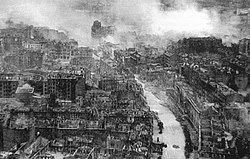Nikita Khrushchev
Nikita Sergeyevich Khrushchev[1] (15 April 1894[2] – 11 September 1971) was the leader of the Soviet Union after the death of Joseph Stalin. He ruled from 1953 to 1964 when Leonid Brezhnev, a Red Army Major General and President of the Soviet Union from 1960 to 1964 (during Khrushchev's own rule) came to power in 1964, just 11 years after Stalin died.
Nikita Khrushchev Никита Хрущёв | |
|---|---|
 | |
| First Secretary of the Communist Party of the Soviet Union | |
| In office September 14, 1953 – October 14, 1964 | |
| President | Kliment Voroshilov Leonid Brezhnev Anastas Mikoyan |
| Premier | Georgy Malenkov Nikolai Bulganin Himself |
| Preceded by | Joseph Stalin |
| Succeeded by | Leonid Brezhnev |
| Premier of the Soviet Union | |
| In office March 27, 1958 – October 14, 1964 | |
| President | Kliment Voroshilov Leonid Brezhnev Anastas Mikoyan |
| First Deputies | Frol Kozlov Alexei Kosygin Dmitriy Ustinov Lazar Kaganovich Anastas Mikoyan |
| Preceded by | Nikolai Bulganin |
| Succeeded by | Alexei Kosygin |
| Personal details | |
| Born | 15 April 1894 Kalinovka, Dmitriyevsky Uyezd, Kursk Governorate, Russian Empire |
| Died | September 11, 1971 (aged 77) Moscow, Russian SFSR, Soviet Union |
| Nationality | Soviet |
| Political party | Communist Party of the Soviet Union |
| Spouse(s) | Yefrosinia Khrushcheva (1916–1919, died) Marusia Khrushcheva (1922, separated) Nina Khrushcheva (1923–1971, survived as widow) |
| Signature |  |
He supported the Soviet space program and was the leader when Yuri Gagarin flew into space and became the first man to leave Earth in April 1961. Khrushchev was also the leader who ordered the Berlin Wall to be built in the East Berlin half of the former Nazi capital city Berlin. The wall separated it from West Berlin in August 1961 until the end of the Cold War .
Early life
Nikita was born in the town of Kalinovka in Russia. He later moved to Ukraine. He worked in mines, and became part of the Bolshevik movement. He was a political commissar in the Red Army in the Russian Civil War and again in World War II and moved his way up in the Communist Party, eventually becoming trusted by Joseph Stalin. When Stalin died, Georgy Malenkov and several others including Khrushchev shared power. Eventually Khrushchev became the leader.
"De-Stalinization"
When Nikita became the leader of the Soviet Union, he began something he called "De-Stalinization". He made a secret speech, in which he denounced Stalin as a man who committed many murders of innocent people. In early 1956, he took down all posters and statues of Joseph Stalin. Also, he moved Stalin's grave to a place where people could not see it.[3]
Relations with the "West"
He also had better contacts with the western countries like the USA, Britain, and France. This means the USSR and the western world were friendlier. He visited America in 1959.[4][5] During this visit, Khrushchev spoke at the United Nations and visited where he wanted, including destinations such as New York and Hollywood. However, his visit to Disneyland was cancelled for security reasons.[6]
But the USSR and the US still did not trust each other. In 1962 America and the USSR had a Cuban Missile Crisis which could have led to nuclear war, but didn't.[7] Khrushchev had bargained with the Americans to get rid of the missiles they had placed in Turkey, for the missiles in Cuba were the only way for withdrawal.[8]
Relations with China
During the period of "De-Stalinization", relations deteriorated between the Soviet Union and China.[9] These policies were viewed by Mao Zedong and the Chinese Communist Party as divergences in the two states interpretations of Marxist-Leninist Doctrine. The resulting tensions were a contributing factor to the Sino-Soviet Split
Death
He died of heart disease on 11 September 1971 in Moscow, aged 77.
Nikita Khrushchev Media
Khrushchev's second wife (though they only officially married in 1965) was Ukrainian-born Nina Petrovna Kukharchuk, whom he met in 1922. Photo taken in 1924
Lazar Kaganovich, one of the chief enforcers of Stalin's dictatorship and Khrushchev's main patron.
Khrushchev (second from right) poses for a photo alongside Joseph Stalin (far right) sometime during the 1930s.
Regional party leaders in 1935. In the front row sits Nikita Khrushchev (Moscow), Andrei Zhdanov (Leningrad), Lazar Kaganovich (Ukraine), Lavrentiy Beria (Georgia), and Nestor Lakoba (Abkhazia) (behind him stands Mir Jafar Baghirov).
The Ukrainian capital, Kiev, after the Second World War.
Georgy Malenkov, the man who briefly succeeded Stalin as leader of the Soviet Union.
Universal Newsreel about Khrushchev's resignation
References
- ↑
 listen (info • help) Russian: Ники́та Серге́евич Хрущёв; IPA: [xruˈɕːʲof]
listen (info • help) Russian: Ники́та Серге́евич Хрущёв; IPA: [xruˈɕːʲof]
- ↑ Tompson 1995, p. 2. Soviet era reports list his birth date as April 17 (April 5 old style) but recent discovery of his birth certificate has made biographers accept the April 15 date.
- ↑ Jennifer Rosenberg. Body of Stalin removed from Lenin's tomb. About.com Guide [1] Archived 2011-11-27 at the Wayback Machine
- ↑ Carlson 2009, p. 247.
- ↑ Taubman 2003, pp. 421–22.
- ↑ "NPR". 'K Blows Top': Reliving Khrushchev's American Tour. June 29, 2009. Retrieved 2016-06-02.
- ↑ Whitman, Alden (1971-09-12), "Khrushchev's human dimensions brought him to power and to his downfall", The New York Times, retrieved 2009-09-25 (fee for article, but available free here)
- ↑ Taubman 2003, p. 575.
- ↑ Taubman 2003, pp. 470–71.
| Preceded by Josef Stalin |
First Secretary of the Soviet Communist Party 1953–1964 |
Succeeded by Leonid Brezhnev |
| Preceded by Nikolai Bulganin |
Prime Minister of the Soviet Union 1958–1964 |
Succeeded by Alexey Kosygin |









